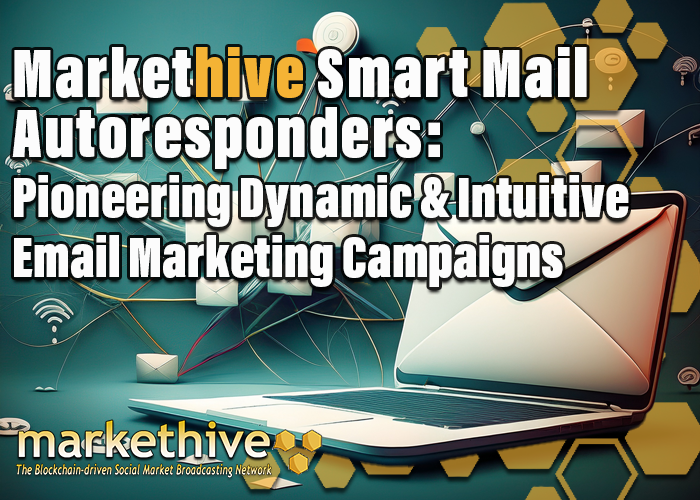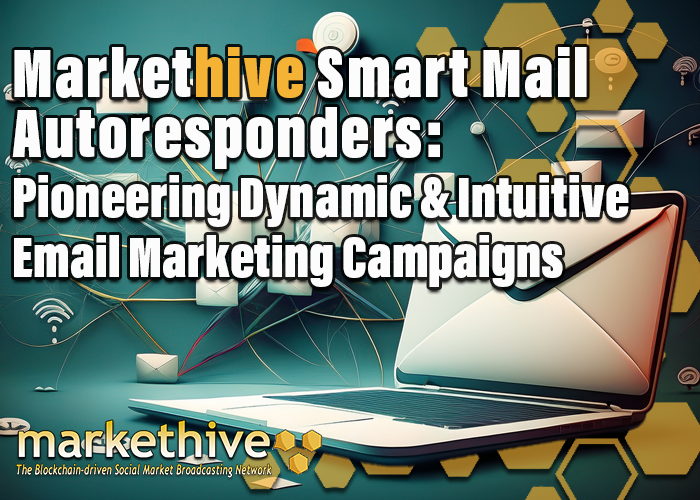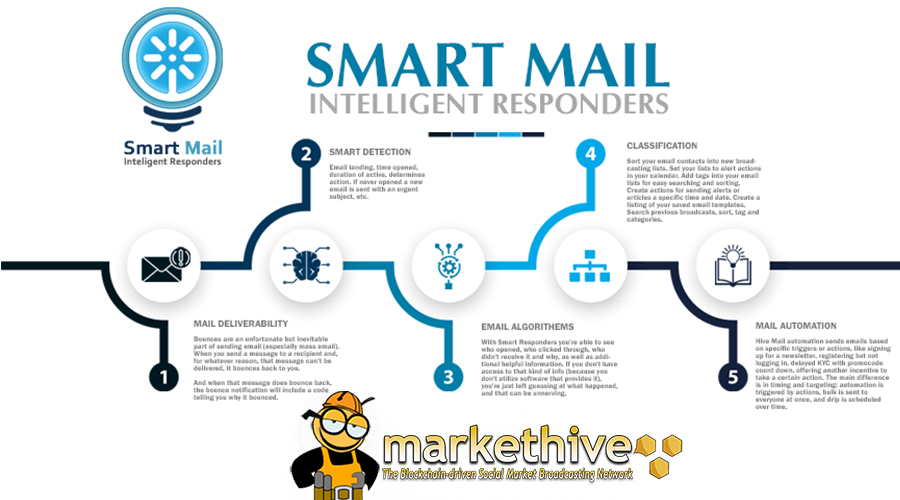
Markethive Smart Mail Autoresponders: Pioneering Dynamic and Intuitive Campaigns

Email, a long-standing communication method, has witnessed the strategic marketing application of autoresponders pioneered by Markethive Founder and CEO, Thomas Prendergast, in 1996. He developed and refined this system, establishing the foundation for Automated Marketing, now known as Inbound Marketing. Email delivery is a key focus at Markethive, forming a significant part of its inbound marketing system. It is recognized for its high deliverability rate, reaching 97% of recipients, with 100% of messages landing in their inbox.
Markethive's email system distinguishes itself through its proprietary OAuth capture technology, a sophisticated mechanism designed to ensure the authenticity and quality of lead and subscriber information. Unlike conventional methods of acquiring email addresses susceptible to spam traps, which are often encountered when harvesting data directly from websites, Markethive's approach prioritizes user consent and verification. This robust system effectively minimizes the inclusion of invalid or malicious email addresses, thereby enhancing deliverability and the overall effectiveness of email marketing campaigns.
OAuth registration ensures robust security through secure socket connection verification. With your consent, it transmits your Name, Email, and profile photo from your email provider to our encrypted database. This step confirms your identity on our platform, enhancing the security of our ecosystem and email deliverability for your communications and the broader community.
This data transfer is limited to identity verification and service optimization; Markethive cannot access your email credentials, email contents, or other personal data beyond the consented information. This approach guarantees a secure experience while respecting your privacy in the digital space.
Markethive provides integrated tools for organically building high-quality email lists. Customizable Capture Widgets can be embedded on websites or within Markethive. Dedicated Capture Pages facilitate focused lead generation. The blogging platform enables readers to subscribe to your blog for future articles and updates. Individual Profile Pages also serve as lead capture points. These methods foster engaged and verified email lists, nurturing meaningful connections and enhancing marketing outcomes.
Markethive Enhances Its Autoresponder System
Markethive's current linear email autoresponder system, which delivers segmented emails daily or on a custom schedule, is being upgraded to a new Smart Mail system. This enhanced system will feature more advanced programming for more dynamic and intuitive email delivery. Smart Mail will track email opens and send subsequent emails based on engagement with the initial message.
The follow-up email sequence depends entirely on the recipient's engagement with the preceding email. The system is designed with a conditional logic that automatically generates different paths or branches in the email flow. This branching is triggered by the recipient's actions, or lack thereof, in response to the initial email. For instance, opening the email might trigger one set of follow-up actions, clicking on a link within the email could initiate another sequence, while not opening the email at all prevents any further communication in that particular flow.
This ensures that recipients only receive relevant and timely follow-up messages based on their demonstrated level of interest. The system dynamically adjusts each recipient's communication strategy based on interaction patterns, optimizing engagement and preventing unnecessary or unwanted emails.
The email delivery report offers an overview of campaign performance. It displays the total emails sent for a specific campaign or timeframe. It clearly shows the count of emails successfully delivered to mail servers. Key metrics include the number of opens, which indicates engagement based on how many recipients opened the emails. The report also outlines the bounce rate, representing the percentage of undelivered emails, categorized into invalid addresses and full inboxes for targeted analysis and improvements in list hygiene.

Smart Mail Intelligent Responders
1. Mail Deliverability
Email bounces are a natural and unavoidable aspect of electronic mail communication, particularly when disseminating messages to large distribution lists. Despite meticulous efforts to maintain and verify email address databases, outdated, non-operational, or temporarily unavailable inboxes pose an inherent challenge. When a mail server encounters a problem delivering a transmitted message to the designated recipient's mailbox, it automatically generates a system-driven reply directed back to the originator of the initial correspondence. This automated feedback mechanism is widely known as a bounce message, a non-delivery report (NDR), or a delivery status notification (DSN).
Importantly, these bounce notifications are not merely acknowledgments of delivery failure; they encapsulate specific alphanumeric codes and descriptive text that provide critical insights into the fundamental reasons behind the unsuccessful transmission. Understanding these diverse bounce codes is essential for executing effective email marketing strategies and maintaining a healthy and responsive subscriber list. By diligently interpreting these codes, senders can identify and resolve underlying issues that may negatively impact their email deliverability metrics.
The analytical process of bounce code interpretation empowers senders to proactively identify and remove erroneous or problematic email addresses from their mailing lists. This crucial practice significantly improves their sender reputation among receiving mail servers and internet service providers (ISPs), enhancing the likelihood of future messages reaching their intended recipients. A focused approach to bounce management ultimately translates into greater success for email marketing campaigns, fostering improved engagement and conversion rates.
Moreover, email bounces are diverse, primarily divided into two categories: 'hard bounces' and 'soft bounces.' Each category indicates a different delivery failure level, requiring the sender's distinct remedial actions. Hard bounces indicate permanent delivery failures, typically due to invalid, nonexistent, or closed email addresses. These are clear signals for addresses that should be promptly removed from the mailing list to safeguard the sender's reputation.
On the other hand, soft bounces refer to temporary delivery challenges, such as a full recipient mailbox, a temporary server issue on the recipient's side, or an overly large message. Although soft bounces suggest a short-term problem and the recipient's address is likely valid, ongoing soft bounces can adversely affect deliverability and may require further investigation or possible removal from the list if the problems continue. Thus, understanding the differences between hard and soft bounces is essential for making informed decisions in email list management and enhancing email marketing results.
2. Smart Detection
The response to an email depends on whether it has been opened, when it was opened, and how long it stayed active. This comprehensive assessment determines the next steps in the communication strategy. For example, if an email is not opened within a specified time frame, the system automatically sends a follow-up email. This follow-up email features a subject line clearly labeled as urgent, designed to grab the recipient's immediate attention and prompt them to engage with the content quickly.
The specific criteria for activating this urgent resend and the precise phrasing of the urgent subject line are adjustable settings in the system's workflow. Additionally, suppose an email is opened, but the time spent actively engaging with it is less than a specified minimum threshold. In that case, this may suggest that the recipient did not completely absorb the information. In these cases, the system may trigger an alternative follow-up action, like dispatching a summary or a targeted reminder connected to the email's main message.
Conversely, if the email is opened and viewed for a sufficient duration, it can be inferred that the recipient has likely engaged with the content, and no further immediate action may be required. The precise metrics for determining sufficient engagement duration and the nature of follow-up actions for various engagement levels are key to optimizing email communication effectiveness. This granular approach ensures that recipients receive appropriate and timely follow-up based on their interaction patterns, enabling more targeted and impactful follow-up communications.
3. Email Algorithms
Smart Responders significantly enhance email communication by providing deep insights into audience engagement through detailed tracking of recipient interactions. This feature offers granular analytics, revealing exactly who opened an email and when, thus assessing immediate interest levels. Additionally, it carefully tracks which recipients engaged further by clicking on embedded links, signifying a higher level of interest or subsequent action. Smart Responders also pinpoint recipients who did not receive the message, avoiding assumptions of universal delivery.
Beyond basic delivery confirmation, this sophisticated tool diagnoses the reasons behind non-delivery, categorizing issues such as invalid or misspelled email addresses, recipients' inboxes exceeding their storage capacity, or messages automatically filtered into spam or junk folders. This level of detail empowers senders to address delivery obstacles and maintain accurate contact lists proactively. Without the detailed intelligence provided by Smart Responders, senders are relegated to making educated guesses and operating under assumptions regarding the success and impact of their email outreach.
This inherent ambiguity creates uncertainty, making it difficult to assess the current communication approaches effectively and, as a result, hindering the ability to strategically refine messaging, content, and delivery methods for optimal audience engagement and desired communication outcomes. The actionable data provided by Smart Responders facilitates a shift from reactive troubleshooting to proactive optimization, ultimately leading to more impactful and efficient email communications.
4. Classification
Transform email communication and scheduling with our comprehensive contact management and broadcast system. Segment your audience by creating targeted broadcast lists, ensuring the delivery of relevant and personalized messages to reach the correct recipients. Enhance productivity by linking these lists to your calendar, enabling timely action alerts for scheduled communications, ensuring crucial outreach is never missed, and executing campaigns flawlessly.
Plan your outreach precisely by scheduling email alerts and article broadcasts for optimal engagement on specific dates and times. You can create listings of your saved email templates and search your complete history of broadcast campaigns. Sort these campaigns according to a wide range of criteria, apply relevant tags for rapid identification and retrieval, and logically categorize them within a structured framework, fostering unparalleled organizational efficiency and clarity.
By centralizing and intelligently managing your contacts and communication schedules, our system empowers you to build stronger relationships, optimize your outreach efforts, and achieve your communication goals efficiently.
5. Mail Automation
Hive Mail's automation capabilities revolutionize customer engagement by enabling businesses to send hyper-personalized and contextually relevant emails triggered by specific user interactions. Unlike generic bulk emails that flood inboxes with irrelevant content or pre-programmed drip campaigns that adhere to a rigid schedule, Hive Mail's automation operates in real-time, responding dynamically to individual user behavior.
Consider the onboarding process for a new member. Instead of a static welcome email, Hive Mail can initiate a sophisticated sequence based on the subscriber's actions. Upon initial signup, a confirmation email can be immediately dispatched. If the user creates an account but doesn't log in, the system can automatically send a reminder email with login instructions and a brief overview of key features.
This proactive approach ensures that new users receive timely and pertinent information, guiding them through the initial stages of engagement and increasing the likelihood of active participation. This level of automated guidance significantly improves the user experience compared to a single, static welcome message that may be quickly forgotten or lost in the inbox.
Furthermore, Hive Mail automation allows for strategically delivering incentives to drive desired behaviors. A compelling example is the delayed KEY with the Promo Code countdown. Setting up a countdown timer that begins after a user triggers a specific action can create a sense of urgency and encourage conversion. These time-sensitive offers are delivered precisely when users exhibit interest, maximizing their impact.
Hive Mail's automation feature provides a decisive paradigm shift in email marketing. Businesses can foster more meaningful and effective customer relationships by moving away from static, one-size-fits-all approaches towards dynamic, event-triggered communication.
Think of it as a tree with multiple branches: These branching automation sequences are intelligently triggered by a wide array of recipient actions, such as opening an email, clicking a specific link, making a purchase, abandoning a shopping cart, or even based on inactivity or reaching a particular milestone. This contextualized approach ensures that each recipient receives messages directly pertinent to their journey and engagement with the brand.
This results in enhanced user engagement, improved conversion rates, and a more personalized and positive overall customer experience. Automating targeted and timely communication based on individual user behavior represents a significant advancement over traditional methods, allowing businesses to communicate more precisely and achieve superior marketing outcomes.
.png)
Conclusion
Moving beyond mass, untargeted email campaigns, a sophisticated email marketing strategy prioritizes the creation of highly personalized communications tailored for distinct audience segments. This requires a deep understanding of each segment, including their unique pain points, aspirations, and areas of interest. By investing time in audience segmentation and the development of targeted content, you can shift away from generic messaging and deliver truly valuable information that directly addresses the specific needs of your subscribers.
This tailored approach ensures your emails are not perceived as intrusive or irrelevant, significantly reducing the likelihood of being marked as spam or ignored. Instead, your communications become a welcomed and anticipated resource, positioning you as a thought leader and a reliable source of expertise within your industry. Regularly providing insightful and actionable content fosters trust and builds stronger relationships with your audience.
Over time, recipients will recognize the value of your emails, eagerly anticipating your updates and viewing them as a valuable addition to their information streams. This consistent delivery of relevant, high-quality content is vital for enhancing your professional reputation, establishing your authority in your field, and fostering a loyal following of engaged subscribers.
.png)

